Clover Hill Railroad
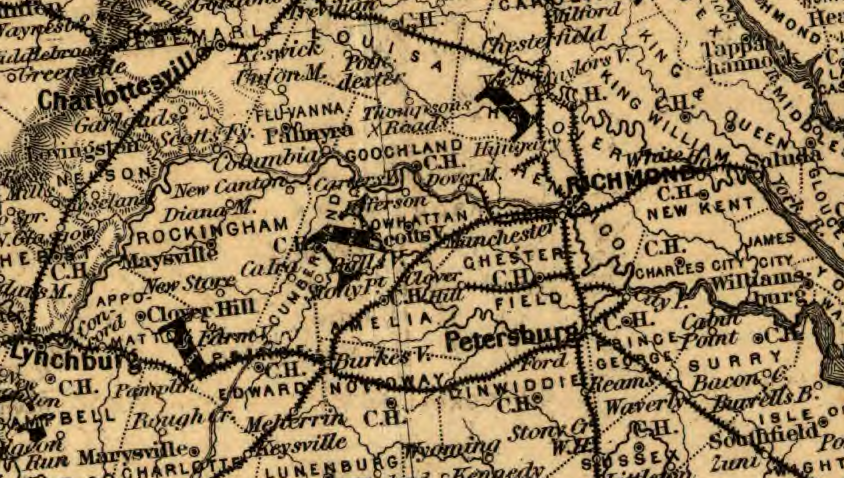
in 1869, the coal was carried north to Richmond or south to Petersburg via the Richmond and Petersburg Railroad
Source: Library of Congress, A map showing the Atlantic Mississippi & Ohio R.R. and its connections from Norfolk to Cumberland Gap via Bristol (1867)
The Clover Hill Railroad was chartered on February 5, 1841. It was built to carry coal from the mine at Winterpock to the James River. The first 18 miles of standard gauge track to a junction with the Richmond and Petersburg Railroad at Chester opened in 1846.
The General Assembly modified the charter two years later, setting a maximum charge for transporting the coal from Chesterfield County.
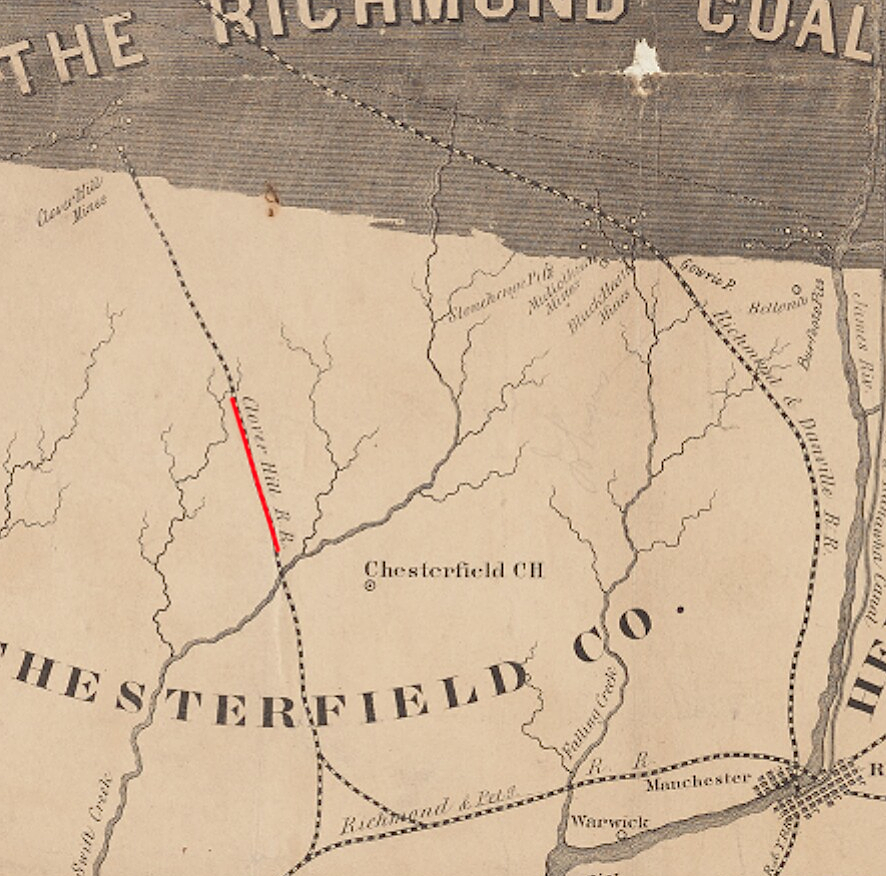
the Clover Hill Railroad was built to haul coal from the Triassic Basin in Chesterfield County
Source: Yale University, Map of the Richmond coal field (by S. Herries DeBow, 1858)
The coal traffic from the Clover Hill Railroad stressed the infrastructure of the Richmond and Petersburg Railroad. The state owned 60% of that railroad, so it improved the company's financial condition in 1850 by suspending the collection of the state's share of the dividends.1
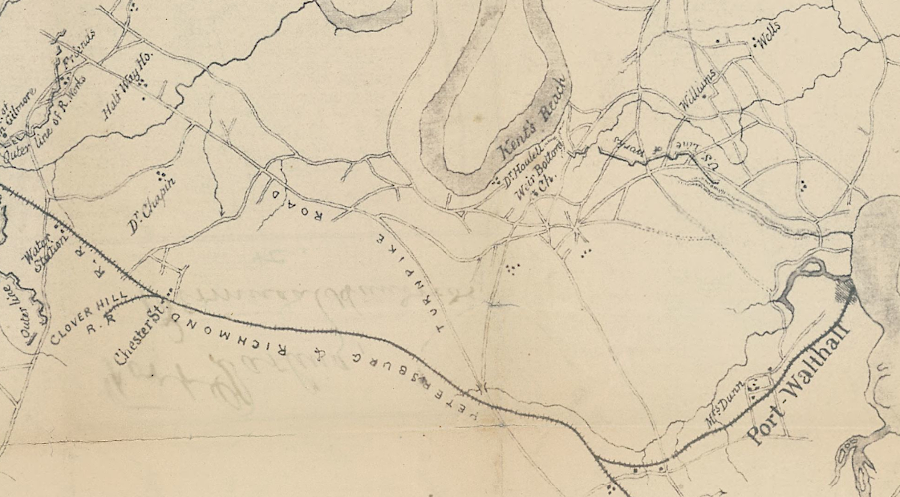
the Clover Hill Railroad initially relied upon the Richmond and Petersburg Railroad to carry coal north to Richmond or south to Port Walthall
Source: Library of Congress, Eastern part of Chesterfield County, Virginia (by L. E. Walker, 1864)
The Clover Hill Railroad built in 1867 a three-mile extension east to the James River, with a wharf opposite Osborne's Landing in Henrico County. That extension eliminated the need to pay the Richmond and Petersburg Railroad to carry coal to a wharf in Manchester or at Port Walthall.1
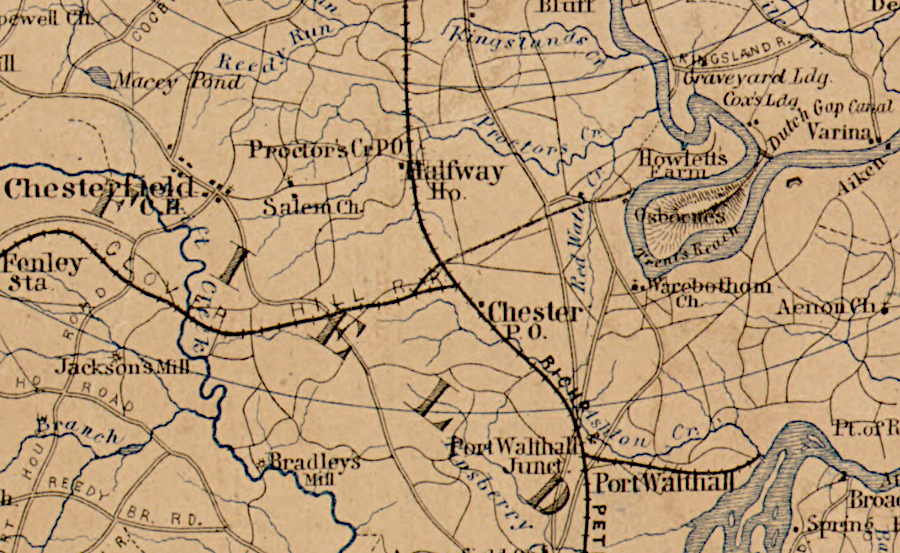
until 1867 the Clover Hill Railroad could transport coal to the James River only via the Richmond and Petersburg Railroad, or via transport by wagon east of Chester
Source: Library of Congress, Thirty five miles around Richmond, Va (by Jedediah Hotchkiss, 1867)
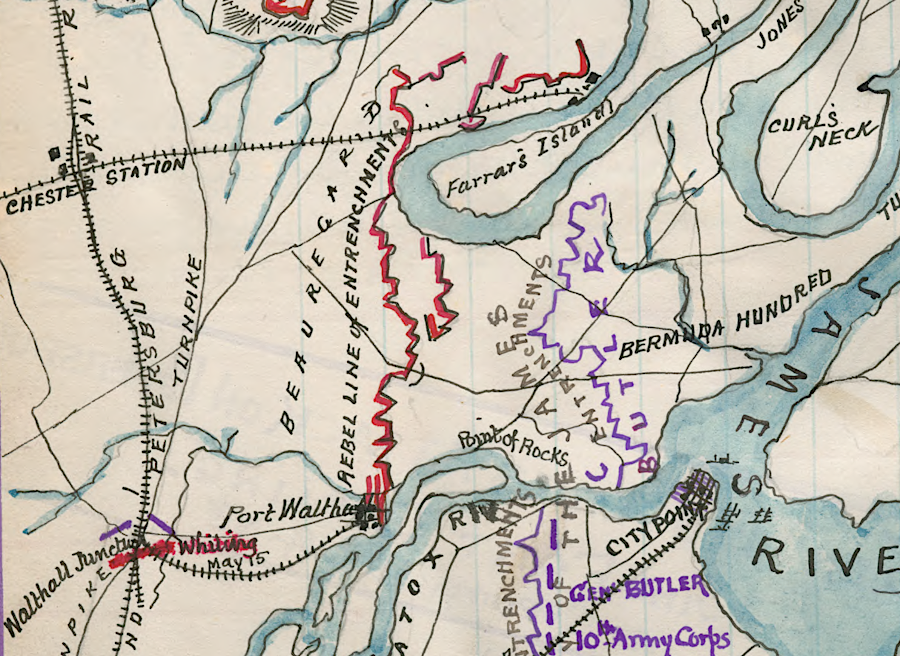
in 1867 the Clover Hill Railroad built three miles past Chester Station to the James River, opposite Osborne's Landing
Source: Library of Congress, Map of operations at Bermuda Hundred and Drewry's Bluff, Virginia, 10th May 1864 (by Robert Knox Sneden)
After the Panic of 1873, the railroad went through bankruptcy and emerged as a reorganized Bright Hope Railway & Coal Company in 1877. At that time, it operated over 21 miles of track.
Completion of the Dutch Gap Canal in 1881 changed the channel of the James River, making it too shallow at the wharf at Osborne's Landing. The Bright Hope Railway pulled up the three miles of track between Chester and the river, converted the remaining 18 miles to narrow gauge, and extended the line on both ends. On the east, it constructed 10 miles of narrow gauge track to a new deepwater wharf at Bermuda Hundred.
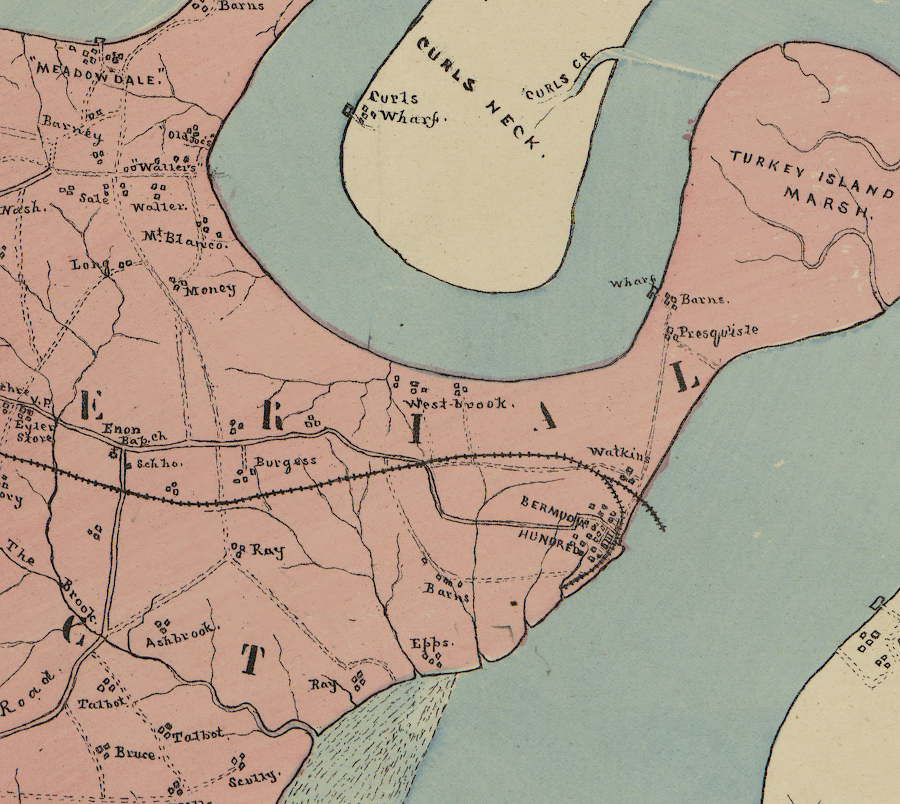
the Bright Hope Railway & Coal Company delivered coal to Bermuda Hundred on the James River
Source: Library of Congress, Map of Chesterfield County, Va (by Joseph Edgar LaPrade, 1888)
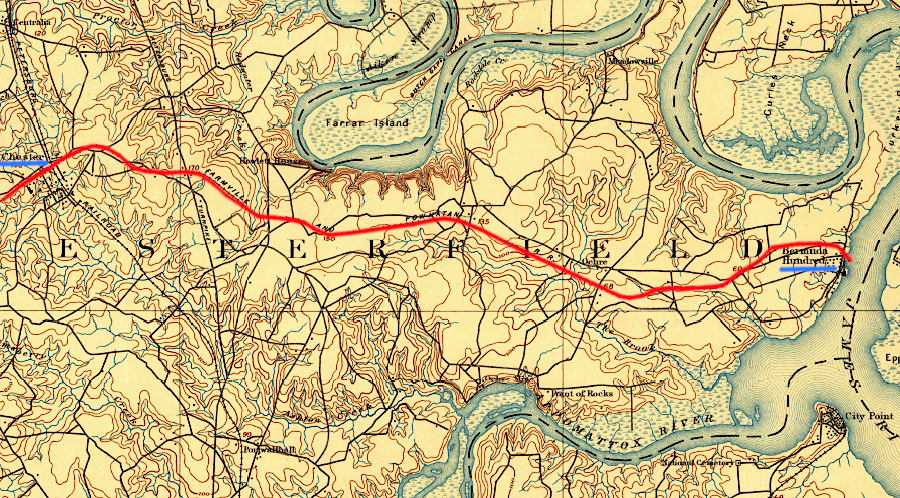
the Farmville & Powhatan Railroad built track to Bermuda Hundred, after the wharf near Osborne's Landing was rendered useless by Dutch Gap Canal in 1881
Source: US Geological Survey (USGS), Bermuda Hundred 1:62,5000 topograpic quadrangle (1894)
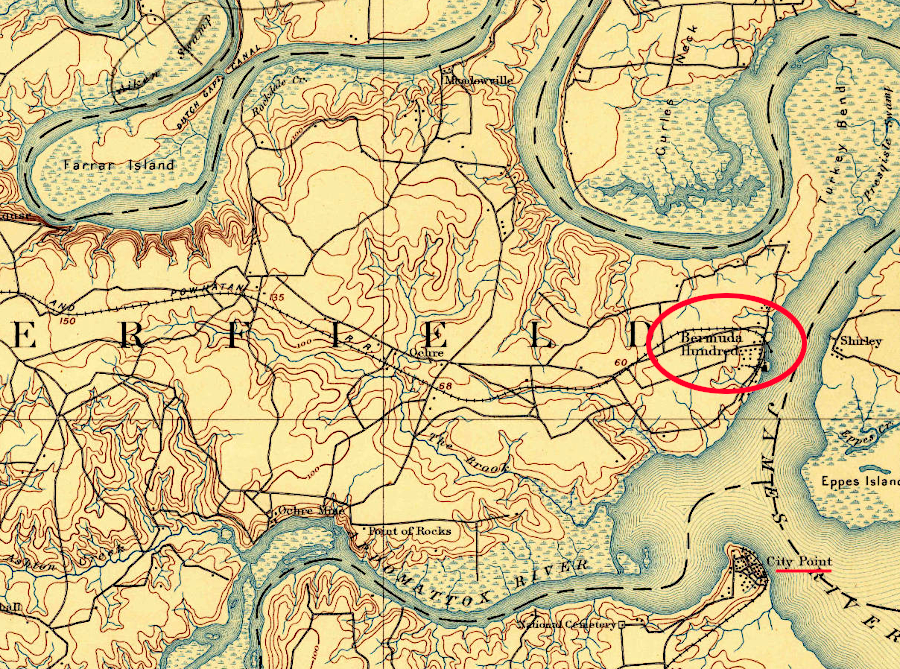
in 1894, the Farmville & Powhatan Railroad port was upstream of the port accessed by the Petersburg and City Point Branch of the Norfolk and Western Railroad
Source: US Geological Survey (USGS), Bermuda Hundred 1:62,5000 topograpic quadrangle (1894)
On the west end, it built four miles of narrow gauge track from the coal mines at Winterpock to the Appomattox River. That extension to Eppes Falls connected with the Upper Appomattox Canal Company, and gave the railroad 32 miles of track.2
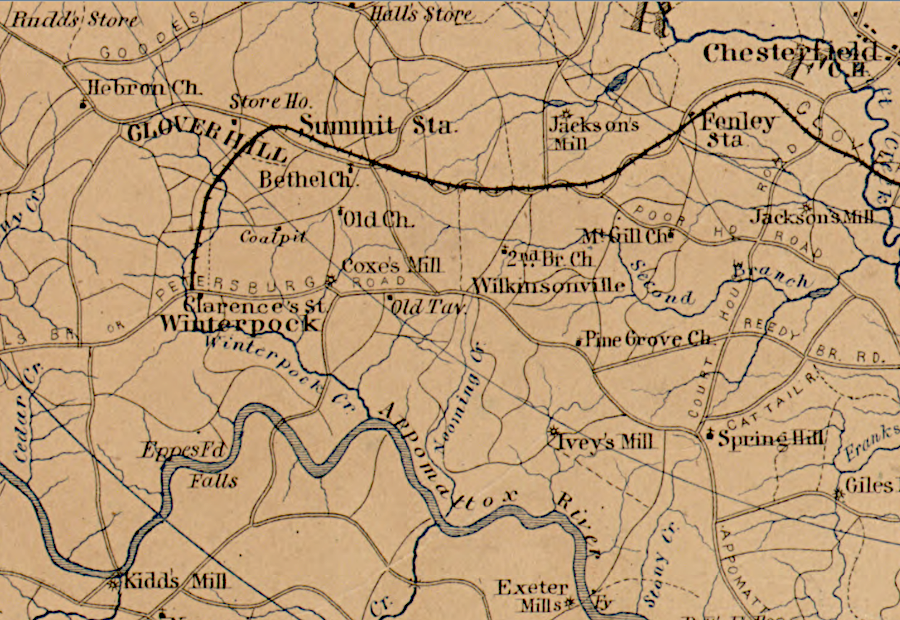
until 1867, the western end of the Clover Hill Railroad was at the Winterpock mines
Source: Library of Congress, Thirty five miles around Richmond, Va (by Jedediah Hotchkiss, 1867)
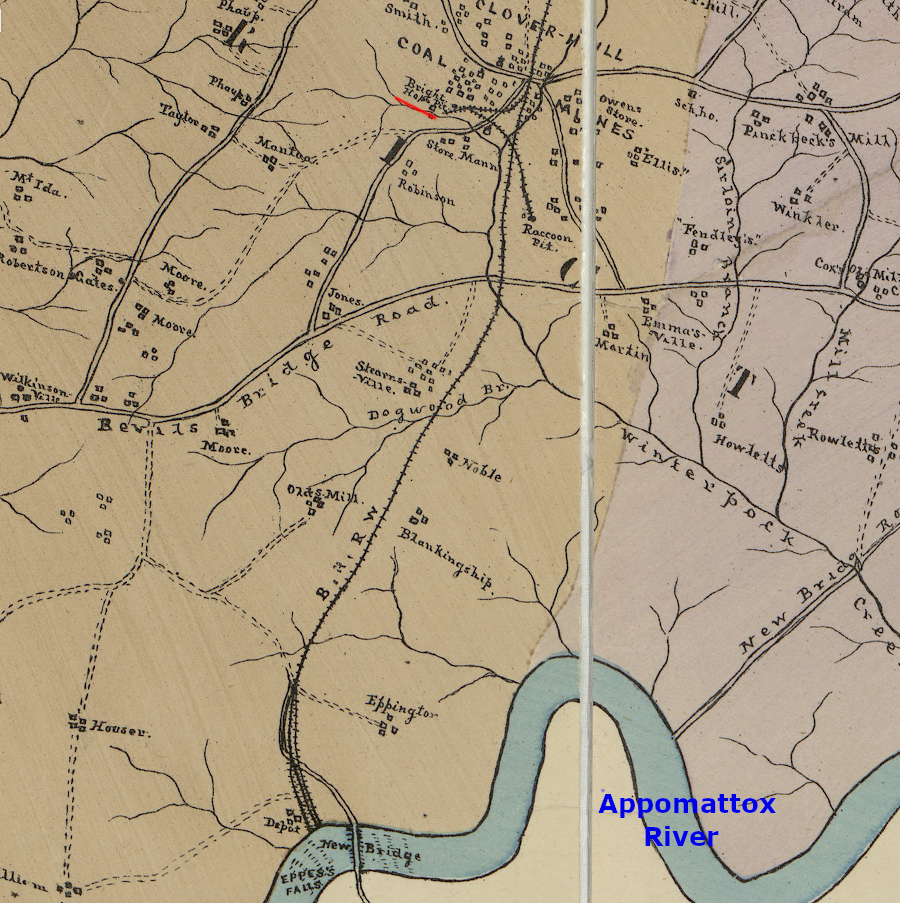
the Bright Hope Railway & Coal Company extended track to deliver coal from the Bright Hope pit to the Appomattox River, for shipment by water to Petersburg
Source: Library of Congress, Map of Chesterfield County, Va (by Joseph Edgar LaPrade, 1888)
In 1884, investors in Cumberland County organized the Farmville and Powhatan Railroad under a charter granted by the General Assembly on March 10, 1884. It acquired the Bright Hope Railway at a foreclosure sale on July 23, 1889. The Bright Hope Railway had been reorganized in 1887 after going bankrupt.3
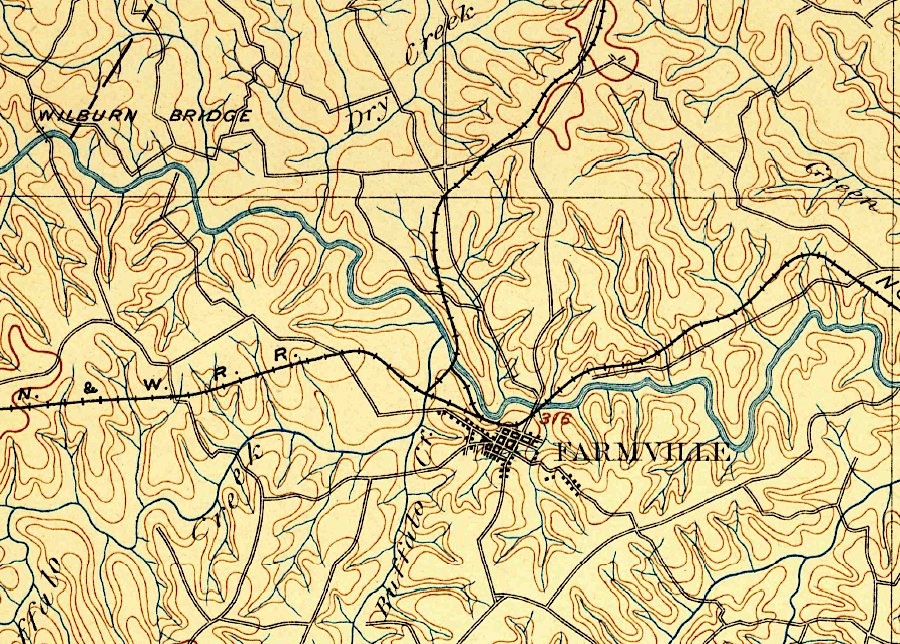
the Farmville and Powhatan Railroad built its own bridge over the Appomattox River to link to the Norfolk and Western Railroad at Farmville
Source: US Geological Survey USGS), Farmville VA 1:125,000 topographc quadrangle (1893)
The Farmville & Powhatan Railroad extended the Clover Hill Railroad/Bright Hope Railway further westward parallel to the Appomattox River. Track within Cumberland and Powhatan counties provided a connection with the Norfolk and Western Railroad at Farmville. The Farmville & Powhatan Railroad ended up with 39 miles of track, including a three-mile spur from Coalboro to a major mine at Winterpock.
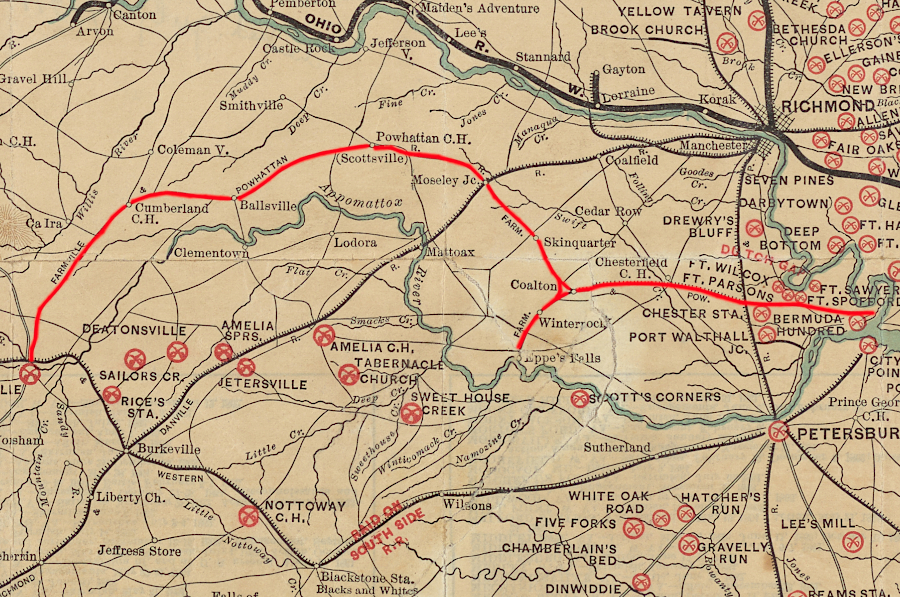
Farmville & Powhatan Railroad in 1891
Source: New York Public Library, Map showing the location of battle fields of Virginia (1891)
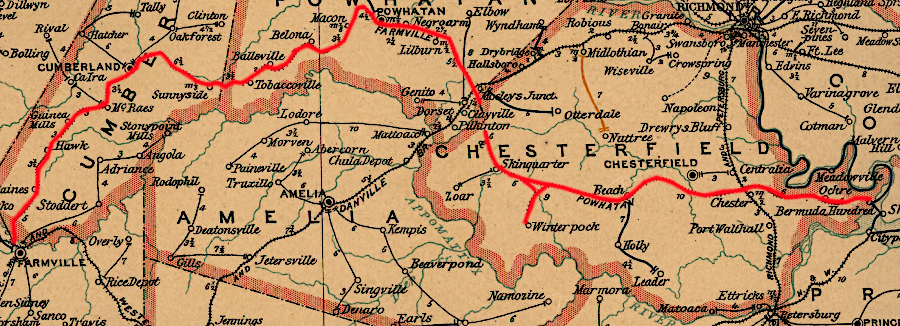
the Farmville & Powhatan Railroad connected Farmville to Bermuda Hundred
Source: Library of Congress, Post route map of the state of Virginia and West Virginia (1896)
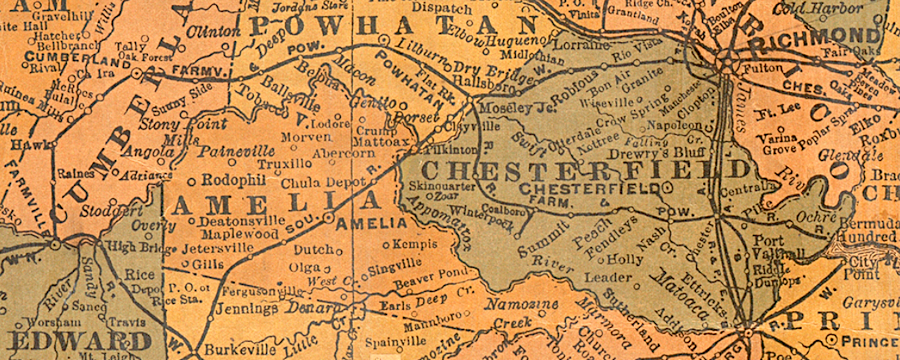
the Farmville & Powhatan Railroad in 1902
Source: Library of Virginia, Rand-McNally new railroad and county map: Virginia and West Virginia (1902)
By 1899, the Farmville & Powhatan Railroad went into receivership. It emerged in 1905 as the Tidewater & Western Railroad.
The Tidewater & Western Railroad lasted until 1917. It was then dismantled, with material shipped to France to support the Allies in World War I.4
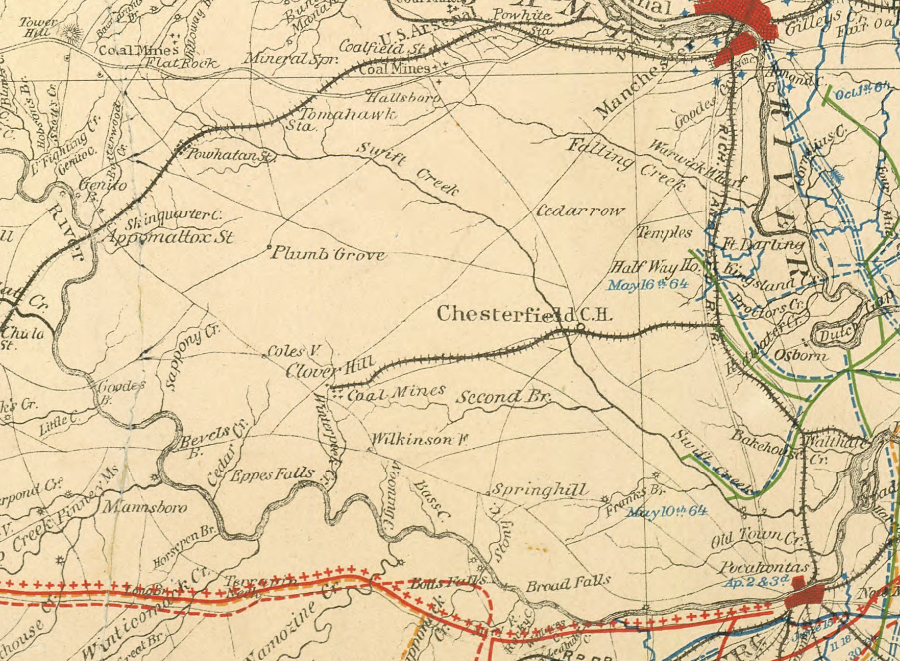
the Clover Hill Railroad was a Union target in 1864
Source: Library of Congress, Central Virginia: showing Lieut. Gen'l. U.S. Grant's campaign and marches of the armies under his command in 1864-5 (US War Department. Engineer Bureau, between 1864 and 1869)
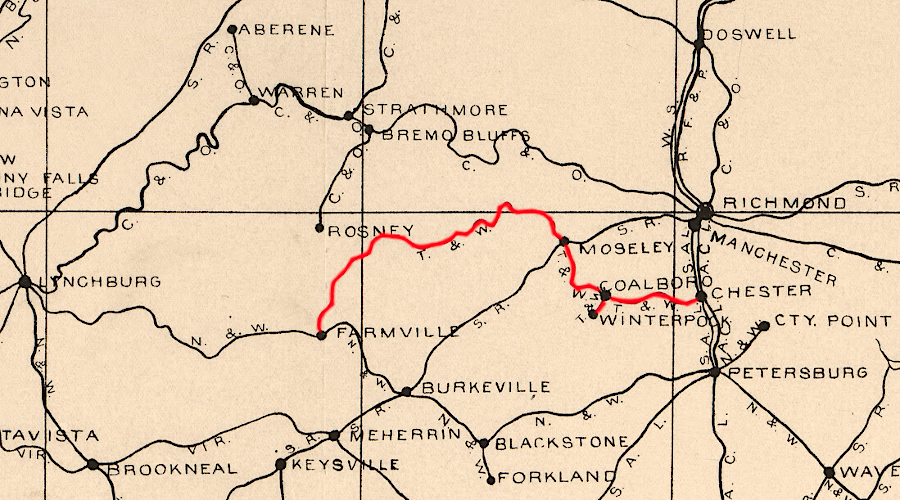
plans for the Tidewater & Western Railroad
Source: Library of Congress, Railway mail map of Virginia (by Earl Palmer Hopkins, 1910)
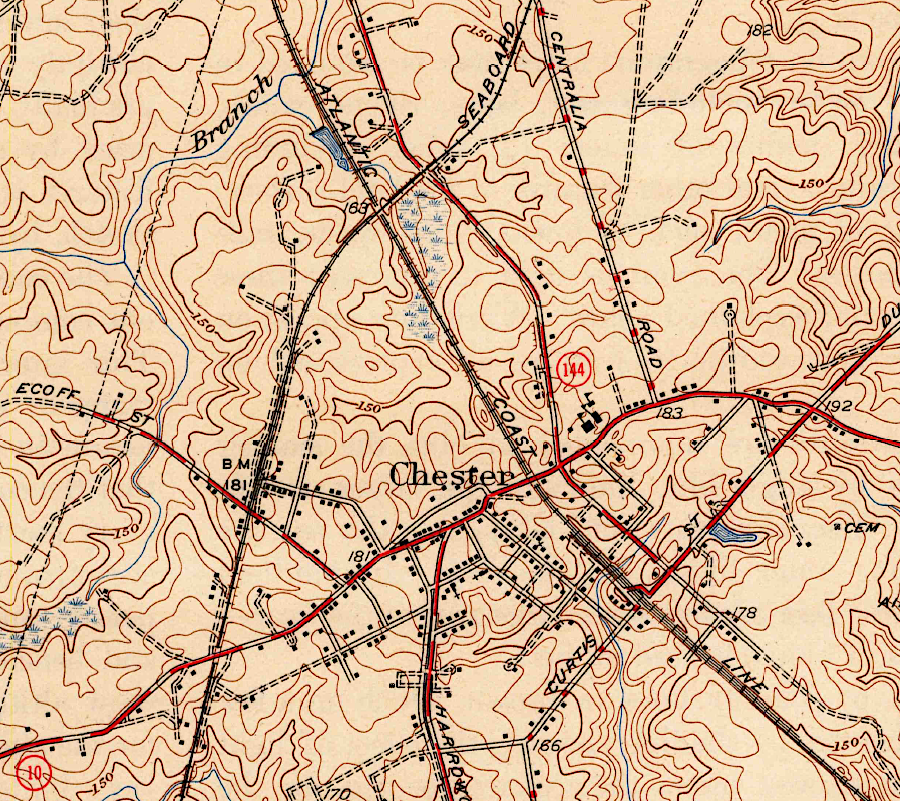
the Seaboard Coast Line crossed the Atlantic Coast Line (which had replaced the Richmond and Petersburg Railroad) near Chester in World War II, but the Tidewater & Western Railroad had been dismantled in World War I
Source: US Geological Survey (USGS), Chester, VA 1:62,500 topographic quadrangle (1944)
Links
References
1. "An Act to Incorporate the Norfolk and Peterburg Railroad," Acts of the General Assembly of the State of Virginia Passed at the Regular and Extra Sessions of 1859 and 1850, Commonwealth of Virginia, 1850, p.56, https://books.google.com/books?id=Y_FQAQAAMAAJ; "An Act, Reviving and Amending the Act Incorporating the Clover Hill Railroad Company," March 27, 1843, Acts of the General Assembly of Virginia Passed at the Session Commencing 5th December 1842 and Ending 28th March 1843, 1843, p.75, https://books.google.com/books?id=JAlAAAAAYAAJ; "Clover Hill Railroad Company records, 1844-1886," ArchiveGrid, https://researchworks.oclc.org/archivegrid/collection/data/261341180; C. F. H. Allen, "Tidewater and Western Railroad," The Railway and Locomotive Historical Society Bulletin, Number 114 (April 1966), https://www.jstor.org/stable/43518179 (last checked June 14, 2020)
2. "Tidewater and Western Railroad Company," Annual Report of the State Corporation Commission of Virginia, 1917, p.973, https://books.google.com/books?id=BN8lAQAAIAAJ; "Annual Report of the State Corporation Commission of Virginia: Compilations from Returns of Railroads, Canals, Electric Railways and Other Corporate Companies" State Corporation Commission, 1917, p.973, https://www.google.com/books/edition/Annual_Report/PdEnAQAAMAAJ?hl=en&gbpv=1&pg=PA973&printsec=frontcover (last checked May 6, 2025)
3. "Farmville and Powhatan Railroad Company," Annual Report, Virginia, Railroad Commissioner, 1898, p.203, https://books.google.com/books?id=mCUaAQAAIAAJ (last checked June 2, 2020)
4. "A side excursion to the Clover Hill Railway, Bright Hope Railway, Farmville & Powhatan Railroad, and Tidewater & Western Railroad," Nelson & Albemarle Railway Historical Society, May 2015, https://sites.google.com/site/nelsonalbemarle/archive-this-month-s-articles/may-2015-article; "Annual Report of the State Corporation Commission of Virginia: Compilations from Returns of Railroads, Canals, Electric Railways and Other Corporate Companies" State Corporation Commission, 1917, p.973, https://www.google.com/books/edition/Annual_Report/PdEnAQAAMAAJ?hl=en&gbpv=1&pg=PA973&printsec=frontcover (last checked May 6, 2025)
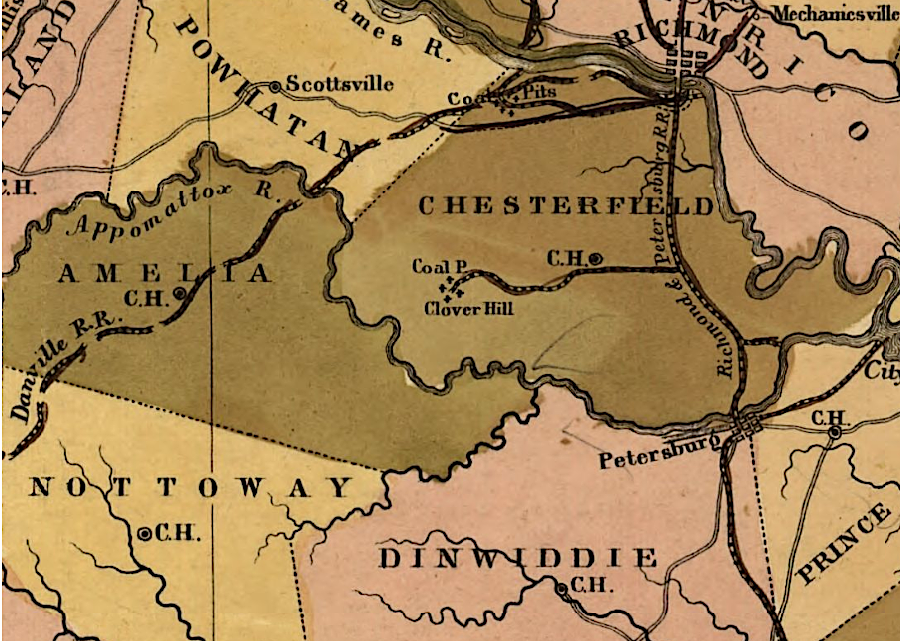
the Clover Hill Railway carried coal east to the Richmond and Petersburg Railroad
Source: Library of Congress, A map of the internal improvements of Virginia (by Claudius Crozet, 1848)
Railroads of Virginia
Virginia Places

















